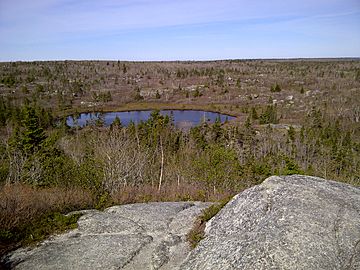South Mountain (Nova Scotia) facts for kids
Quick facts for kids South Mountain |
|
|---|---|
 |
|
| Highest point | |
| Elevation | 279.8 m (918 ft) |
| Geography | |
| Location | Annapolis Valley, Nova Scotia |
| Parent range | Appalachian Mountains |
| Topo map | NTS |
| Climbing | |
| Easiest route | drive/hike |
South Mountain is a mountain range in Nova Scotia, Canada. It is also known as Montagne du Sud in French and Beinn a Deas in Gaelic. This long, rocky ridge is made of a type of rock called granite. It stretches from the Annapolis Basin all the way to Mount Uniacke.
South Mountain forms the southern edge of the beautiful Annapolis Valley. It helps protect the valley from strong winds and weather coming from the Atlantic Ocean. Together with North Mountain, these two ranges create a special area called the Annapolis Highlands.
What is South Mountain?
South Mountain is different from its neighbor, North Mountain. South Mountain rises slowly from the Atlantic coast over many kilometers. But then, it drops sharply on its northern side. This steep side forms the southern wall of the Annapolis Valley.
This mountain range is also known as the South Mountain Batholith. A batholith is a very large mass of igneous rock, usually granite, that forms deep underground. This batholith is the biggest collection of granite rocks in the entire Appalachian Mountains. It includes areas with bare granite rocks and higher granite lands. Scientists believe it formed a very long time ago, during the late Devonian Age.
Highest Point
The very highest spot on the South Mountain ridge does not have a specific name. It is located in Kings County. This point is about 26 kilometers (16 miles) southeast of Berwick. It is also close to Lake George.

